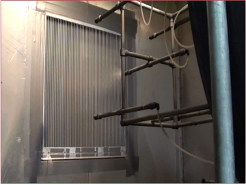In the realm of architectural innovation, precision is paramount, especially in critical infrastructures like data centres, where downtime is simply unacceptable.
Real testing stands as the cornerstone of reliability. There is an irreplaceable value in physically testing architectural louvres in real-world conditions. Environmental factors such as wind velocity, temperature differences and even subtle disturbances, cannot be accurately replicated in a virtual environment. Real testing provides architects and engineers with tangible, real time data, allowing them to observe, measure and adapt louvre designs in response to actual conditions.
Real testing embraces unpredictability, accommodating the unexpected and enables designers to refine their designs based on actual performance metrics and practical challenges that might not emerge in a controlled environment. This process of testing, refining and retesting is invaluable in crafting louvres that meet the demands of data centre environments.

In developing and innovating architectural louvres for data centres, where air cooling is still the most dominant way of ventilating 90% of data centres compared to liquid or immersion cooling, real testing holds unmatched authority. It ensures louvres are not only aesthetically pleasing, but also functionally superior, enhancing airflow efficiency, guarantee equipment cooling and maximising energy efficiency.
When it comes to ensuring optimal performance, the choice between real testing and Computational Fluid Dynamics (CFD) becomes pivotal.
CFD are computer generated simulations that offer a digital platform for designers, that could fall short in capturing the intricacies of real-world scenarios and making assumptions about airflow patterns and environmental variables. In complex structures like data centres, minute variations could potentially lead to significant differences and unexpected challenges during implementation.
Investing in real testing over CFD represents a commitment to quality and signifies understanding the intricacies between form and function. Physical tests in real-world conditions provide tangible and measurable results. Beyond the technical aspects, investing in real testing instils confidence and peace of mind knowing that the selected louvres have undergone rigorous real-world testing, ensuring full function and protection when installed.
At Construction Specialties we pride ourselves on our real testing processes.
It is fundamental to our innovation and product development. Real testing is the cornerstone of our operations, providing tangible assurance that comes with physically testing our louvres under various conditions. It allows the observation of real-time reactions to airflow and weather, to ensure optimal performance in the environments they will ultimately be fitted to. This commitment assures our clients that they are investing in quality that meets Australian standards, withstands the test of time and serves as the first line of defence to guard against water ingress and pressure drops.
Precision and efficiency are essential when we are catering to the unique needs and high standards of hyper-scale Australian data centres, with currently over $1 billion of investment underway. These advanced facilities demand solutions that not only provide aesthetics but also optimise airflow, temperature, and energy efficiency.
Real testing is more labour-intensive than CFD. To date, CFD has not proven feasible for modelling wind-driven-rain and still-air-water-penetration performance. The numerous variables, such as droplet size, surface tension, and spray conditions, add significant complexity compared with more common types of CFD analysis, such as fluid flow through pipes. CFD has its merits during the research and development phase, providing directional insights into whether Louvre A might outperform Louvre B. However, CFD technology doesn’t always translate into real-world results. While it may offer cost reductions overall, it compromises the nuanced precision that real testing provides.

Construction Specialties Australia provides the most superior storm resistant dual stage vertical blade performance louvre models such as the RS-5605 and RSV-5700. These models are Air Movement and Control Association (AMCA) International approved and meet stringent design standards as the first line of defence in a data centre for rain ingress and pressure drops.
AMCA certification signifies adherence to the industry’s most rigorous design and performance standards, including the AMCA-550-L standard to which all louvres are tested. The ANSI/AMCA standard 500-L covers five testing protocols: pressure drop; airflow leakage; water penetration; wind-driven rain and wind-driven sand. It’s important to note that AMCA doesn’t recognise CFD results, and they are not certifiable.

In addition to AMCA Certification, Construction Specialties has confirmed the accuracy of the data with an accredited third party, ensuring the guidelines and certification program for louvres.
Designers and data centre owners must recognise the long-term benefits of investing in real tested and quality louvres, ensuring longevity, reliability and peace of mind for years to come